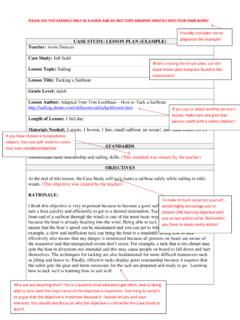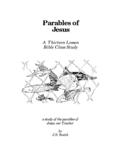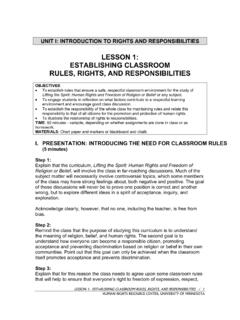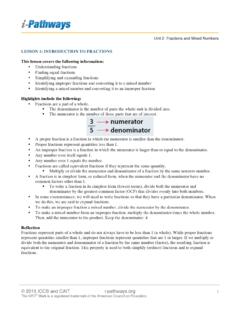Transcription of AIR POLLUTION TRAGEDY: A CASE STUDY
1 Air POLLUTION tragedy : A case STUDY lesson . Air -The Search for One Clean Breath. Page 1 Ventura County Air POLLUTION Control District, Ventura, CA Learning Objective Students will be able to: Recognize that public awareness and activism can prevent or minimize air POLLUTION tragedies. AIR POLLUTION tragedy : A case STUDY lesson Concepts: Students will build awareness that many disciplines of STUDY and areas of interest can contribute to solving a public problem. Students will build awareness of past air POLLUTION disasters by reviewing historic accounts. Grade Levels: 9-12 California Science Standards Grade 9-12 Ecology Students know how to analyze changes in the ecosystem resulting from changes in climate, human activity, introduction of nonnative species, or changes in population size. National Science Standards Grade 9-12 Science & Technology Content Standard F: Science in Personal and Social Perspective.
2 Education and the Environment Initiative Educational Principles and Concepts Principle IV: The exchange of matter between natural systems and human societies affects the long-term functioning of both. As a basis for understanding this principle: Concept a. Students need to know that the effects of human activities on natural systems are directly related to the quantities of resources consumed and to the quantity and characteristics of the resulting byproducts. Concept b. Students need to know that the byproducts of human activity are not readily prevented from entering natural systems and may be beneficial, neutral, or detrimental in their effect. Link to Air The Search for One Clean Breath from Executive Producer Barbara L. Page In the film, we present the air POLLUTION disasters in Donora, Pennsylvania, and in London, England. In Donora, we visit survivors Bill and Gladys Schempp. Bill was on the fire department during that event and literally crawled door-to-door to deliver oxygen to Donora residents.
3 But there is another historical air POLLUTION event we can learn from: the 1930 tragedy in Belgium s Meuse Valley. Materials Resource sheets Advanced Preparation Make copies of Resource 1 information sheets for student groups. Time and Student Grouping One or two 50 minute class periods; students will work in six groups to read, summarize and report on evidence to solve a mystery. Procedure 1. Inform students they will be engaging in a forensic exercise to determine the cause of death of people in an area of Brussels in the 1930s. 2. Group students into six teams: Medical doctors (two groups); Climatologists; Geologists; Chemists; Industrialists. Each student group will read and discuss the information sheet provided to them. (See Resource 1 for case studies.) 3. The teacher will lead a class discussion during which time students will report their findings to the class. As information is provided to the class from each group, the teacher or a student chosen by the teacher, will post findings on a chart for all to read.
4 4. As a group, class will discuss findings and propose solutions to the mystery. Vocabulary Autopsy: The medical examination of a dead body in order to establish the cause and circumstances of death. Inversion layer: A layer of the atmos-phere in which there is a temperature inversion, with a warmer layer tending to prevent the air below it from rising, thus trapping any pollutants that are present. Air POLLUTION tragedy : A case STUDY lesson . Air -The Search for One Clean Breath. Page 2 Ventura County Air POLLUTION Control District, Ventura, CA Teacher Background Since the Industrial Revolution, there have been several occurrences of mass illness and death due to air POLLUTION from factories. While none of these tragedies were intentionally perpetrated, factory owners and government officials were reluctant to place blame on the factories due to concerns about production, profit, and liability.
5 In each case , scientific investigation determined causes based on the combination of chemicals released and their affect on human physiology, geographic, and climatic conditions. Teacher Tips The forensic exercise provided is designed to build students interest in the nature of a catastrophe through role playing one of the many scenarious which could provide information to help solve the puzzle of the mysterious deaths. Information provided to the students is targeted to lead to a quick resolution of facts without involved research. As groups present their summaries, the teacher should chart the factors most important in solving the problem. Emission of chemical POLLUTION from the factories, chemical changes occurring when the POLLUTION combines with water, symptoms of respiratory problems in autopsies and medical exams, and the nature of the valley experiencing an inversion layer are the evidence the teacher would want to highlight for the students to conclude that emissions from the factories in combination with geography and weather lead to the deaths.
6 Most of the time damage due to POLLUTION is not obvious but that doesn t mean it isn t there. Discussion of the benefit of employment at the factories can be weighed against the idea of public health concerns. The medical group is presented with information that lung disease is also caused by smoking cigarettes. If the medical group uses this information to offer a solution, the teacher should point out the suddenness of the medical emergency as it relates to the long time period over which people have smoked. Have copies of Resource 3, Why Should You be Concerned About Air POLLUTION ?, available for groups who finish early to read and review. Closure: Discuss with the class that a cause of a mystery can always be investigated. Scientific investigation will usually involve many disciplines: medical, chemical, geological, industrial, and political. It is important to carefully consider evidence presented for accuracy and thoroughness.
7 Assessment: Understanding the Meuse Valley tragedy involves input from a number of disciplines and points of view. To assess student understanding of this situation, have them write a persuasive or expository essay to the prompt: You are the mayor of a town which has just experienced an environmental catastrophe. Detail how you will oversee the investigation and what type of tests you would employ to ensure a quality conclusion. Extension: Students read Air POLLUTION and Historic Tragedies (Resource 2) and discuss ways in which other tragedies can be prevented. Homework: Students will read about preventative measures taken to guard against such tragedies. Article entitled Why Should You Be Concerned About Air POLLUTION ? (Resource 3). Resources: The Journal of Industrial Hygiene and Toxicology, Year 1937, Volume 19, Pages 126-137. EPA: Related Web Sites: Kyoto Protocol: Air POLLUTION tragedy : A case STUDY lesson .
8 Air -The Search for One Clean Breath. Page 3 Ventura County Air POLLUTION Control District, Ventura, CA Resource 1 case STUDY Meuse Valley, Belgium The Meuse Valley in Belgium contains many farms, villages, steel mills, factories, and chemical plants. Its main claim to fame is an 80 year old mystery, still the subject of speculation today. Early in December of 1930 a thick fog lay over much of the country. Over three days, from December 2 through December 5, many people who lived in the Meuse Valley complained of nausea, difficulty breathing, stinging eyes, and burning throats. By the end of the three days, 60 people had died and thousands more were ill with an unknown disease. Had they been sprayed with poisonous gas? Were there leaks of gases from the chemical plants? Was it another outbreak of bubonic plague? You have been named to a commission to determine what caused the deaths and illnesses.
9 You will need to become an expert about certain facts of the case . Meterologists: As a team, determine if the following conditions could have contributed to the deaths and illnesses. A. The weather was cold, a little above freezing during the day. At night the tempera-ture reached 10 below. B. Temperatures had been falling in the days before the deaths, and heavy fog formed as moist air cooled near the ground. C. There was an unusual weather pattern called a temperature inversion. Warm air usually rises, but in valleys like the Meuse (and Los Angeles) during the winter, once the sun goes down the ground loses heat very quickly which cools the air near the ground. Because air does not conduct heat very well, the air above the surface remains warmer by comparison. Colder air does not rise through warmer air. Therefore, there is little mixing of air. D. There was no wind those three days in the Meuse Valley.
10 Air POLLUTION tragedy : A case STUDY lesson . Air -The Search for One Clean Breath. Page 4 Ventura County Air POLLUTION Control District, Ventura, CA Resource 1 case STUDY Meuse Valley, Belgium The Meuse Valley in Belgium contains many farms, villages, steel mills, factories, and chemical plants. Its main claim to fame is an 80 year old mystery, still the subject of speculation today. Early in December of 1930 a thick fog lay over much of the country. Over three days, from December 2 through December 5, many people who lived in the Meuse Valley complained of nausea, difficulty breathing, stinging eyes, and burning throats. By the end of the three days, 60 people had died and thousands more were ill with an unknown disease. Had they been sprayed with poisonous gas? Were there leaks of gases from the chemical plants? Was it another outbreak of bubonic plague? You have been named to a commission to determine what caused the deaths and illnesses.







